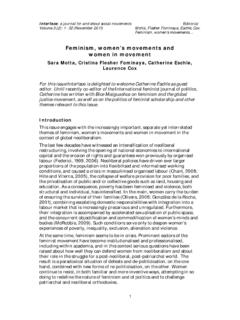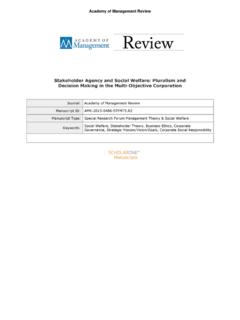Transcription of Critical Theories: Marxist, Conflict, and Feminist
1 CHAPTER693 Critical theories : marxist , Conflict, and FeministAt the heart of the theories in this chapter is social stratification by class and power, and they are the most politicized of all criminological theories . Sanyika Shakur, aka Kody Scott, came to embrace this Critical and politicized view of society as he grew older and converted to Afrocentric Islam. Shakur was very much a member of the class Karl Marx called the lumpenproletariat (a German word meaning rag proletariat ), which is the very bottom of the class hierarchy.
2 Many Critical theorists would view Shakur s criminality as justifiable rebellion against class and racial exploitation. Shakur wanted all the material rewards of American capitalism, but he perceived that the only way he could get them was through crime. He was a total egoist, but many Marxists would excuse this as a trait that is nourished by capitalism, the root cause of crime. From his earliest days, he was on the fringes of a society he clearly disdained. He frequently referred to whites as Americans to emphasize his distance from them, and he referred to black cops as Negroes to distinguish them from the New African Man.
3 He called himself a student of revolutionary science and rebellion, and advocated a separate black nation in concepts dominated Shakur s life as he battled the Bloods as well as other Crips subsets whose interests were at odds with his set. It is easy to imagine his violent acts as the outlets of a desperate man struggling against feelings of class and race inferiority. Perhaps he was only able to achieve a sense of power when he held the fate of another human being in his hands. His fragile narcissism often exploded into violent fury whenever he felt himself being dissed.
4 How much of Shakur s behavior and the behavior of youth gangs in general are explained by the concepts of Critical theories ? Is violent conflict a justi-fiable response to class and race inequality in a democratic society, or are there more produc-tive ways to resolve such conflicts ? Critical theories : marxist , Conflict, and Feminist94 CRIMINOLOGY: THE ESSENTIALSy The Conflict Perspective of SocietyAlthough all sociological theories of crime contain elements of social conflict, consensus theories tend to judge alternative normative systems from the point of view of mainstream values, and they do not call for major restructuring of society.
5 theories presented in this chapter do just that, and concentrate on power relationships as explanatory variables to the exclusion of almost everything else. They view criminal behavior, the law, and the penalties imposed for breaking it, as originating in the deep inequalities of power and resources existing in society. For conflict theorists, the law is not a neutral system of dispute settlement designed to protect everyone, but rather the tool of the privileged who criminalize acts that are contrary to their don t have to be a radical or even a liberal to acknowledge that great inequalities of wealth and power exist in every society and that the wealthy classes have the upper hand in all things.
6 History is full of examples: Plutarch wrote of the conflicts generated by disparity in wealth in Athens in 594 (Durant & Durant, 1968, p. 55), and President John Adams (1778/1971) wrote that American society in the late 18th century was divided into a small group of rich men and a great mass of poor engaged in a constant class struggle (p. 221).y Karl Marx and RevolutionKarl Marx is the father of Critical criminology. The core of Marxism is the concept of class struggle: Freeman and slave, patrician and plebian, lord and serf, guildmaster and journeyman, in a word, oppressor and oppressed, stood in constant opposition to one another (Marx & Engels, 1948, p.)
7 9). The oppressors in Marx s time were the owners of the means of production (the bourgeoisie), and the oppressed were the workers (the proletariat). The bourgeoisie strives to keep the cost of labor at a minimum, and the proletariat strives to sell its labor at the highest possible price. These opposing goals are the major source of conflict in a capitalist society. The bourgeoisie enjoys the upper hand because capitalist societies have large armies of unemployed workers eager to secure work at any price, thus driving down the cost of labor.
8 According to Marx, these economic and social arrangements the material conditions of people s lives determine what they will know, believe, and value, and how they will and his collaborator Friedrich Engels (1948) were dis-dainful of criminals, describing them in terms that would make a New York cop proud: The dangerous class, the social scum, that rotting mass thrown off by the lowest layers of the old society (p. 22). These folks came from a third class in society the lumpenproletariat who would play no decisive role in the expected revolution.
9 For Marx and Engels (1965) crime was simply the product of unjust and alienating social conditions the strug-gle of the isolated individual against the prevailing conditions (p. 367). This became known as the primitive rebellion hypothesis, one of the best modern statements of which is Bohm s (2001): Crime in capitalist societies is often a rational response to the circumstances in which people find themselves (p. 115). Photo For Karl Marx (1818 1883), the resolution of social problems such as crime would be achieved through the creation of a socialist society characterized by communal ownership of the means of production and an equal distribution of the fruits of these labors.
10 Chapter 6. Critical theories : marxist , Conflict, and Feminist 95 Another concept that is central to Critical criminology is alienation (Smith & Bohm, 2008). Alienation is a condition that describes the distancing of individuals from something. For Marx, most individuals in capitalist societies were alienated from work (which they believed should be creative and enjoyable), which led to alienation from themselves and from others. Work is central to Marx s thought because he believed that while nonhuman animals instinctively act on the environment as given to satisfy their immediate needs, humans distinguish themselves from them by consciously creating their environment instead of just submitting to it.

















